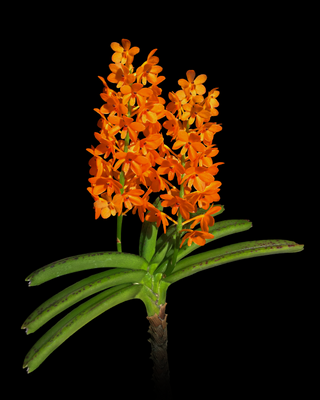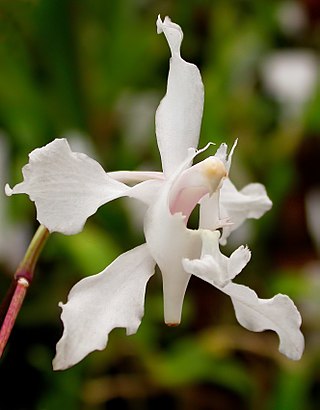
Pleione is a small genus of predominantly terrestrial but sometimes epiphytic or lithophytic, miniature orchids. This genus is named after Pleione, mother of the Pleiades, and comprises about 20 species. Common names of this genus include peacock orchid, glory of the east, Himalayan crocus, Indian crocus and windowsill orchid. The genus DiploconchiumSchauer is generally included here. Pleione is abbreviated to Pln in trade journals.

Vanda, abbreviated in the horticultural trade as V., is a genus in the orchid family, Orchidaceae. There are about 87 species, and the genus is commonly cultivated for the marketplace. This genus and its allies are considered to be among the most specifically adapted of all orchids within the Orchidaceae. The genus is highly prized in horticulture for its showy, fragrant, long-lasting, and intensely colorful flowers. Vanda species are widespread across East Asia, Southeast Asia, and New Guinea, with a few species extending into Queensland and some of the islands of the western Pacific.

Aerides, known commonly as cat's-tail orchids and fox brush orchids, is a genus belonging to the orchid family. It is a group of tropical epiphyte orchids that grow mainly in the warm lowlands of tropical Asia from India to southern China to New Guinea. They are valued in horticulture for their racemes of showy, fragrant, colorful flowers.

Acampe, abbreviated as Acp in horticultural trade, is a genus of monopodial, epiphytic vandaceous species of orchids, distributed from tropical Asia from India, eastwards to China and southwards to Malaysia, and the Philippines as well as from tropical Africa, Madagascar and islands of the Indian Ocean. The name Acampe was derived from the Greek word akampas, meaning "rigid", referring to the small, brittle, inflexible flowers.

Encyclia is a genus of orchids. The genus name comes from Greek enkykleomai, referring to the lateral lobes of the lip which encircle the column. It is abbreviated as E. in the horticultural trade.

Vanda christensoniana is a species of orchid endemic to Vietnam. The specific epithet christensoniana honours the botanist and taxonomist Eric Christenson.

Vanda cristata is a species of orchid found growing in the Himalaya from Bangladesh, India, Nepal, Bhutan to China at elevations of 600 – 2300 meters.

Microsaccus is a genus of flowering plants from the orchid family, Orchidaceae. It is native to Southeast Asia.

Vanda garayi, or Garay's ascocentrum, is a small monopodial epiphytic orchid native to semi-deciduous and deciduous dry lowland forests of Thailand, Laos, and Sumatra.

Vanda xichangensis is a species of epiphytic orchid native to China South-Central.

Vanda richardsiana is a species of epiphytic orchid native to China South-Central. It differs in the spur length from Vanda falcata. Some authors dispute this species status and regard it as a subspecies of Vanda falcata. Dr. Martin Motes argues against effective isolating mechanisms of the length of the spur. Accorting to Motes, the variation of this characteristic easily falls within a species range of variation and further research might reduce it to a varietal status.
Pelatantheria rivesii is a species of epiphytic or lithophytic orchid occurring in China, Laos and Vietnam. This species closely resembles Pelatantheria insectifera bothin its vegetative and generative morphology. The commonly branched stems may reach lengths of 1 m and diameters of 7 mm. Few flowers are produced during October on short racemes, which do not exceed the length of the leaves. The flowers are small and fleshy and the sepals and petals are pale yellow and bear striped. The labellum is pink.
Pelatantheria ctenoglossum is a species of epiphytic or lithophytic orchid occurring in China, Cambodia, Laos and Vietnam. This species closely resembles Pelatantheria bicuspidata both in its vegetative and generative morphology. It can also be easily confused with Pelatantheria woonchengii. The main difference lies in the morphology of the labellum. The specific epithet "ctenoglossum", meaning "comb tongue", refers to the comb like epergencies of the distal portion of the labellum. The stems are erect and rigid and bear fleshy, lanceolate and unequally bilobed leaves. The sepals are ovate, obtuse and have red striations on a yellow base colour. The labellum is fleshy and three-lobed. The column bears tufted white hairs at its base. The chromosome count is 2n = 38.
Pelatantheria eakroensis is a species of epiphytic or lithophytic orchid occurring in Vietnam. The plants are endemic to southern Vietnam.

Papilionanthe vandarum is a species of epiphytic orchid native to India, China, Myanmar, and Nepal. Is is closely related to Papilionanthe biswasiana.

Papilionanthe tricuspidata is a species of epiphytic orchid endemic to the Lesser Sunda Islands, Indonesia. Its status remains an enigma and some individuals were identified as hybrids involving Papilionanthe teres. The species was described as difficult to flower and only producing small flowers. It occurs sympatric with Vanda limbata and supposedly with "Vanda purpurea", which does not appear to be any known species or synonym. Like all members of the genus, this species bears terete leaves on a slender stem.

Papilionanthe pedunculata is a species of epiphytic orchid native to Cambodia, and Vietnam. This species is a floristic component of the South Annamese endemism center, which is characterised by isolated, uplifted plateaux and high mountain systems. They are also found in dry lowland Dipterocarp forests in southern Vietnam. The plant has obvious xeromorphic features and is adapted to these dry conditions. The cool-growing plant occurs at 1200 to 1300 m. The plants are large and terete.

Phalaenopsis difformis, also known as the dark brown Phalaenopsis, is a species of epiphytic orchid native to Assam, Borneo, China South-Central, China Southeast, East Himalaya, Laos, Malaya, Myanmar, Bangladesh, Nepal, Sumatera, Thailand, Vietnam and West Himalaya.

Phalaenopsis hygrochila, also known as 湿唇兰 in Chinese, is a species of epiphytic orchid native to Assam, Borneo, China South-Central, China Southeast, East Himalaya, Laos, Malaya, Myanmar, Bangladesh, Nepal, Sumatera, Thailand, Vietnam and West Himalaya.

Phalaenopsis gibbosa is a species of orchid native to China South-Central, Laos and Vietnam.















